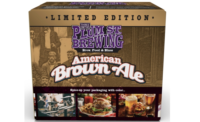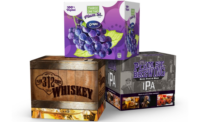As a relatively new technology, digital print has only recently started to seep into the packaging market. But in a short space of time, this new capability has gained immense popularity as those in the packing industry realize its potential for providing seamless and personalized advertising. Market research company, Smithers Pira (smitherpira.com) has already put a value on this fast-emerging industry; an exclusive report from 2015 predicted the global industry to be worth $10.5 billion - and this figure is expected to reach $14.4bn come 2018. This makes digital print for packaging one of the most rapidly growing areas of print. This isn’t surprising, seeing as the capabilities of digital technology are continuously expanding, making it an increasingly cost-effective option when compared to analogue printing.
How digital prints for packaging is affecting the market
So how is digital print affecting the packaging market? The main change we’ll see is as a result of the flexibility digital print will bring; the ability to change designs quickly and easily and without major cost is allowing packaging manufacturers the opportunity to grow. Digital printing is enabling companies to vary their production quicker based on demand, managing their inventory in a more agile way.
Brands are also becoming more able to respond to consumer behavior with a higher degree of precision; research carried out by brands into why people buy their products suggests that many people do so based on a reaction to certain types of graphics and colors within packaging. Designing packaging that meets these complex needs has, until now, required a huge investment. Digital print is enabling more creativity and personalization within smaller budgets, meaning that companies can tailor packaging towards different groups of customers and changing consumer behavioral patterns. This flexible approach will no doubt be more effective for brands and therefore put digital packing in increasing demand.
For these reasons, packaging (which includes types such as folding boxes, labels and flexible packaging) is the only sector within the global print industry that will grow significantly; an expected growth rate of 3.3% per year will take the value of packaging to ¢141bn by 2020.
Sustainable and eco-friendly packaging and labeling
There are two trends that are becoming more significant in the packaging industry. The first is the new rise of consumerism in developing economies. A new wave of middle-class spenders is creating a demand for packaging that relates to individual markets but is also inspiring and aspirational. Second, demand among consumers for more environmentally-friendly packaging is increasing. As Smithers Pira found in its report, consumers are increasingly eco-aware and it is important to them to know that the packaging they buy is not harming the environment and has been produced in an ethical and responsible way. According to Smithers Pira, the market for sustainable packaging is on track to reach $244 billion by 2018; so it’s no wonder that eco-packing is high on the agenda for brands in all industries and meeting that expectation from consumers is likely to be the biggest challenge facing companies by 2023. This is likely to be an even greater consideration that reducing production and packaging costs.
This is where digital printing will step in. A far more sustainable alternative to traditional printing methods, digital printing methods reduce waste typically produced during the printing process. Furthermore, it uses up to four times less ink and removes the need for plates, which, according to Brett Anderson, packing advisor at Nosco, adds up to 30% reduction in carbon footprint. Short runs are often the biggest culprits when it comes to waste; however, by using digital means, the implications - not to mention the cost - of short runs are minimized significantly.
Advantages of digital print and labeling
Brands are fast becoming aware of the advantages of digital printing and, the more they start to experience these benefits for themselves, the more we will see digital infiltrating the packaging industry. The first benefit is flexibility; companies can print on demand with minimal waste and are able to order only the amount that is needed, rather than costly bulk orders. Then there’s cost; no plates and less press set up time means the costs for digital printing are lower for short run labels compared to using analogue methods -and of course, when you take away the need for plates and multiple complex apparatus, you have the added bonus of a quicker turnaround time on runs.
There is also the ability to produce short print runs in a cost-effective manner, which - as brands develop more awareness around - makes digital printing methods a sound investment for the future. Labels that are produced in high definition with high-quality graphics and colors are those that attract the most attention from consumers; digital enables a level of detail previously missed by analogue printing methods that make it a superior choice. And this high quality is what will lead to a positive reputation for brands over time. Poor packaging to consumers means poor product; many impressions are formed within the first few seconds of looking at a product’s packaging, so digital will enable a look and feel that consumers will immediately respect and respond to.
Major players are joining the digital revolution
As brands start to demand this technology, major players in the printing and packaging industry are starting to equip themselves with new capabilities. No one is championing this revolution more than market leader HP. In 2013, it launched the HP Indigo 20000 - which was without a doubt the most significant move to date in digital printing and marked the start of the movement into the mainstream. That same year, HP and KBA unveiled the world’s first HP PageWide Web Press T1100S, a huge inkjet rotation with a width of almost three meters.
In fact, the company believes digital printing is already in the mainstream and has installed more than 1,000 digital presses. Competitor Xeikon is also investing heavily in digital, with more than 300 digital systems in place. Even the more traditional companies are getting involved, such as Heidelberg. Heidelberg has bought Gallus (the company) and rebranded/launched digital printing systems under that brand with the Primefire and Labelfire presses.
Another innovation comes from Landa; its W10 digital web press was designed to offer a cost-effective printing solution with an ultra-fast turnaround time. The system can be used to print various mainstream packaging applications onto standard plastics using simple digital technology that requires no setup.
Opportunities brought by digital print and labeling
Coca Cola’s recent packaging campaign, Share a Coke, highlighted the opportunities available to brands through digital labelling and is a terrific example of the impact of digital and personalized printing on a large consumer base. The company created huge interest among the general public by enabling people to personalize their own named labels, as well as find labels in shops with a friend’s name on. This catapulted the capabilities of digital printing forward and showed the full extent of what is possible using these new methods. Largely thanks to Coke’s campaign, labelling now makes up the bulk of digital printing demand - almost 90% - with a value of $6 billion.
Further opportunities also lie in product introductions, launches and testers; it is easy to test a new product to the market using temporary or introductory packing using digital methods. Limited editions are also much easier to print, enabling brands to really tap into this consumer demand for meaningful, personalized and one-off products.
Many much-loved brands already push sales through introducing limited editions - think companies like Cadbury that frequently introduces temporary flavors to push sales on some of its favorite products e.g. Lion White, Snickers White, and ultimately, its ‘Spectacular 7’, a limited edition bar with its own packaging and branding and of which only 50 were ever made. Through flexible packaging, Cadbury has been able to respond to the demands of its customers, while also tapping into a consumer trend to buy highly desirable, unique and enviable products.
Another great example is Oreo, which created customized wrapping for its much-loved cookies in the US. Personalized messaging on limited edition Oreo packaging bumped the retail price up from $1.99 to $10. Again, in the food sector, Australian store Myer offered customized jars of Nutella for $12.95 each last year, selling more than 400,000 across the state of Victoria and becoming the most popular-selling item of the Christmas season.
It is clear that there are huge opportunities for brands to tap into this new revolution - and many companies are already showing how digital printing can be used to take product packaging to the next level. Products that are personalized, unique, empathetic and eco-friendly are what today’s consumer now demands and expects; not only can digital printing help brands to meet those expectations, but it can provide an immediate and cost-effective way for brands to change and morph as consumer needs continue to rapidly evolve.
This article has been submitted by Graphic Packaging Europe, graphicpkgeurope.com


